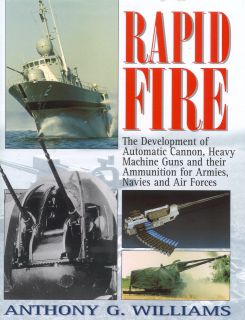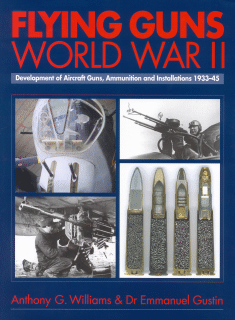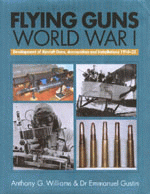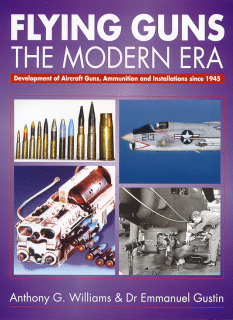| Recommended reading for those interested in technical military history: |

|

|
||

|

|
For details, click the covers. |
| A recent British book claims that these Tempests outgunned and could outspeed all contemporaries. It is a matter of record that eight .50-cal machine guns or one 20-mm plus four .50s can throw a much greater weight of lead in a given period than four 20-mm cannon can. |
These pages try to describe the evolution of fixed fighter armament, with emphasis on the armament of WWII fighters. To give an overview of the texts:
- This page, the introduction, also contains the acknowledgments and some addresses.
- There is a page about WWI fighter armament, to provide an historical background.
- Gun performance tables are given for aircraft guns used during WWII. These discuss guns that saw actual combat service. Prototype guns are ommitted here.
- Some generalities about ammunition are also discussed.
- A related subject is discussed in a few notes about ballistics and gunsights.
- An important section discusses the armament combinations installed in some WWII fighters.
- There is also an analysis of the evolution of fighter armament during the war.
- Upward-firing guns and Schräge Musik, typical armament installations for nightfighters, have their own page.
- I also added a page on big guns and their use in WWII aircraft. Most of these were not used in fighters.
- A lengthy discussion of defensive gun installations.
- There is a postscript discussing the armament of post-war fighters.
- There is a Fighter Armament Table listing fighters since 1934 and their armament.
- A graphical equivalent of these is provided in a number of interactive Java graphs of fighter armament, or a page with simpler figures for those who don't have browsers that support Java. There are some problems with the applets on a number of browsers, I don't know why.
- There is a page with a number of open questions and a reply form, and of course a page with the answers received.
- As a conclusion, a list of sources. There is also a page with various notes.
Introduction
The subject of World War II fighter armament could be delineated by the start and end dates of the war, but of course the aircraft did not suddenly appear and disappear at these dates. However, there is a suitable technical definition. During World War I and most of the interbellum, the armament of a typical biplane fighter consisted of two rifle-calibre machineguns, installed in the upper decking of the front fuselage, with the breeches within reach of the pilot so that he could clear stoppages. Although some fighters of WWII still had this form of armament, it was quickly abandoned by most. This occured almost simultaneously with the introduction of the monoplane fighter: The higher combat speeds and the sturdier construction of modern aircraft required more powerful armament. The different construction of a cantilever monoplane also made it possible to install guns within the wings.
The end of World War II armament is also established fairly clearly. During the war fighters were armed with what are generally called linear action guns. Such guns have a single barrel and a single chamber, so that the actions of chambering the round, firing the gun, and ejecting the case have to be performed sequentially. The WWII armament was still used during the Korean War, but soon thereafter revolver and rotary cannon entered service. They did not replace the linear action guns completely: The latter were retained for some years by fighters of the US Navy and the USSR. But rotary and revolver cannon have dominated the field since the 1950s.
At the end of WWII the Germans had developed the MG 213C revolver cannon. Such a weapon has multiple chambers in a rotating cylinder, so that rounds can be processed in parallel. For example, at the same time when one round is fired, two or three are being chambered and an empty case is being removed from another chamber. Obviously, this significantly increases the possible rate of fire. An alternative design is the rotary gun, often called "Gatling" gun, which not only has multiple chambers but also multiple barrels. This eliminates the need for a seal between the barrel and the rotating chambers, but the gun is bulkier and heavier. Generally, rotary guns have a higher rate of fire, but a relatively long spin-up time, so that if only a short burst is fired, the revolver gun puts out about as many rounds as the multi-barrel gun. Modern fighter guns are either revolver guns or rotary guns, with the notable exception of the Russian GSh-30-1.
The specifics of gun action were generally derived from a few basic designs. Especially the Browning and Oerlikon designs were much copied. Refinement could substantially increase the rate of fire of a gun, for example the Browning .50 was boosted from 750rpm in the M2 version to 1200rpm in the post-war M3 version. But all other things being the same the rate of fire is lower for a gun with a larger calibre, because the ammunition and the working parts of the gun are heavier, and therefore larger forces are needed to move them. For similar reasons, a gun with a high muzzle velocity fires slower than one with a low muzzle velocity. Especially for 20mm and 30mm cannon it was a challenge to increase the rate of fire, and substantial improvements were achieved during the war.
It is not the purpose of these pages to explain gun action. However, there is one that deserves comment and that is the Oerlikon design, a derivative of the WWI Becker design. Nine cannon listed in the gun tables are Oerlikon guns or copies of them, and the reader might grasp that these guns were light and popular, but also that most of them were slow-firing, and that although this design was popular in the early years of the war, it later fell out of favour. (See Note 2.) The operating principle behind these weapons is known as Advanced Primer Ignition Blowback. Basically, this means that the rear end of the chamber is not closed by a part that is locked in place, as in more conventional designs. Instead, the chamber is extended to a greater length than is required by the length of the round, and a sliding bolt follows the cartridge into the chamber, driven by a powerful spring. The propellant is ignited while the cartridge and bolt are still moving forward into the chamber. The inertia of the heavy forward-moving bolt guarantees that the sliding bolt is not expelled from the rear of the chamber before the projectile has left the barrel and the gas pressure has dropped again. Depending on the design, firing the gun compresses or extends the spring, thus providing the energy for firing the next round. The rate of fire of such a design is linked to the resonance frequency of the bolt-and-spring assembly; and as the bolt needs to be fairly heavy, the rate of fire is usually low. Another consequence is that the cartridge cases invariably have rebated rims, otherwise they could not be pulled from the extended chamber.
Acknowledgements and addresses
I started this page with optimism and a fair amount of naivity, but fortunately I quickly received comments and help from two people who are far more knowledgeable about guns than I am, Tony Williams and Ted Bradstreet. Most of the gun data on this page have been contributed by them. If you have specific information about WWII aircraft guns, especially unpublished information that you would like to share, you can also contact Tony Williams T.Williams@mmu.ac.uk or Ted Bradstreet Ted.Bradstreet@state.me.us.
Other helpful contributors of information for this page were C.C. Jordan, Ruud Deurenberg, David McKay, Gorka L. Martinez Mezo, Yuji Sasaki, Antonio Maraziti, and Ron Lapp.
If you have any additional information for this page, you can e-mail me at gustin@uia.ua.ac.be.
Next: What preceded
Emmanuel Gustin
gustin@uia.ua.ac.be